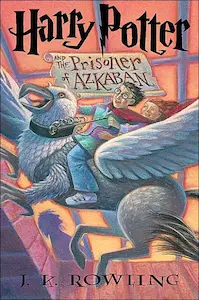Harry Potter and the Prisoner of Azkaban - Summary
J.K. Rowling

Introduction
Harry Potter and the Prisoner of Azkaban, written by J.K. Rowling, is the third installment in the beloved Harry Potter series. Published in 1999, this fantasy novel takes readers on a thrilling journey filled with magic, adventure, and the exploration of complex emotions. In this book summary, we will delve into the captivating plot, remarkable characters, and the underlying themes that make this novel a true masterpiece.
The Plot Unveiled
The story begins with Harry Potter, a young wizard attending Hogwarts School of Witchcraft and Wizardry. As Harry enters his third year at Hogwarts, he learns about Sirius Black, a dangerous convict who has escaped from the wizarding prison, Azkaban. Fearing for his safety, the school is heavily guarded, but Harry’s curiosity and determination lead him to uncover the truth about Sirius Black.
The Mysterious Prisoner
One of the central characters in the book is Sirius Black, who is believed to be responsible for the death of Harry’s parents. However, as the plot unfolds, it becomes clear that there is more to Sirius than meets the eye. Rowling skillfully weaves a tale of redemption and sacrifice, challenging readers’ initial perceptions of the character. Through various anecdotes and interactions, we witness the complexity of Sirius Black’s past and the impact it has on Harry’s journey.
Time-Turner and the Power of Time
A fascinating addition to this installment is the introduction of the Time-Turner, a magical device that allows the user to travel back in time. Hermione Granger, one of Harry’s closest friends, possesses this enchanting artifact, which plays a crucial role in the story. Rowling cleverly utilizes the Time-Turner to create a web of intricate events, showcasing the power and consequences of altering time. This element adds depth to the narrative, leaving readers captivated and pondering the implications of such a device.
The Marauder’s Map
Another intriguing aspect of the story is the Marauder’s Map, a magical parchment that reveals the secret passages and locations within Hogwarts. Created by Harry’s father and his friends during their time at school, this map serves as a valuable tool for Harry and his friends as they navigate the castle’s hidden pathways. Rowling’s use of the Marauder’s Map not only adds excitement to the plot but also emphasizes the importance of friendship and loyalty.
The Dementors and the Battle Against Fear
Throughout the novel, Rowling introduces Dementors, soul-sucking creatures that guard Azkaban. These eerie beings represent the embodiment of fear and despair, haunting both the characters and the readers. Harry, who has a unique connection to the Dementors, must confront his deepest fears and find the strength to overcome them. Rowling’s portrayal of the Dementors serves as a metaphor for the challenges we face in life and the importance of resilience in the face of adversity.
The Complexity of Friendship
Friendship is a recurring theme in the Harry Potter series, and it is particularly prominent in The Prisoner of Azkaban. Harry, Ron, and Hermione’s bond is tested as they face various obstacles together. Rowling expertly explores the complexities of friendship, showcasing the highs and lows, the loyalty and disagreements that come with it. Through their interactions, readers learn the value of trust, forgiveness, and the power of standing united against adversity.
The Triumph of Good Over Evil
As with the previous books in the series, The Prisoner of Azkaban highlights the eternal struggle between good and evil. Voldemort, the primary antagonist, continues to cast a dark shadow over Harry’s life. However, Rowling introduces new characters and alliances that aid in the fight against evil. The novel emphasizes the importance of courage, love, and the choices we make in shaping our own destinies.
Magical Creatures and Enchanting Settings
Rowling’s ability to create vivid and enchanting settings is evident throughout the book. From the magical village of Hogsmeade to the eerie grounds of the Shrieking Shack, readers are transported to a world filled with wonder and imagination. Additionally, the introduction of new magical creatures, such as Buckbeak the Hippogriff and the mischievous Boggart, adds depth and excitement to the story.
Themes of Identity and Belonging
The Prisoner of Azkaban delves into the theme of identity and the search for one’s place in the world. Harry, who has always felt like an outsider, discovers more about his parents’ past and his own heritage. This exploration of identity resonates with readers, reminding them of the universal desire to understand who we are and where we belong.
Conclusion
In Harry Potter and the Prisoner of Azkaban, J.K. Rowling once again captivates readers with her masterful storytelling and imaginative world-building. Through a compelling plot, memorable characters, and thought-provoking themes, Rowling invites readers of all ages to embark on a magical journey filled with adventure, friendship, and the triumph of good over evil. This third installment in the Harry Potter series continues to enchant and inspire, leaving readers eagerly anticipating the next chapter in Harry’s remarkable story.